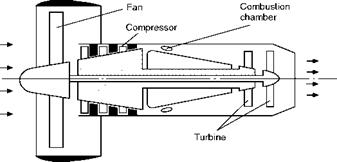High by-pass and turbofan engines
In order to make a jet engine more efficient, we need to arrange it so that a larger mass of air is somehow given a smaller increase in speed. The method used is to increase the size of the compressor fan and to allow a proportion of the air to pass round the outside of the engine. The momentum given to this ‘by-pass’ air contributes to the thrust. There are also a number of secondary advantages, the most significant being a reduction in noise. Another function of the by-pass air is to help cool the engine and to make use of some of the otherwise wasted heat to increase the thrust.
By increasing the amount of by-pass air, the so-called fan jet (see Fig. 4.5, overleaf) was evolved. The fan is not really part of the gas turbine compressor, and may sometimes be mounted at the rear of the engine.
Attempts to increase the efficiency still further lead to even larger fans until they become ducted propellers, or eventually unducted advanced turboprops, so that after many stages of development we will have come full circle back to the propeller! Lower by-pass engines will still however be required for very high-speed flight.
After so much talk of efficiency it is as well to remember that efficiency is not everything! We sometimes want value at all costs rather than value for money. The thrust given by a jet engine is almost independent of speed, while the thrust of a propeller, especially if it is of fixed pitch, falls off badly both above and below a certain speed. It is thrust that enables us to fly and gives us performance, and sometimes we may be more than willing to pay the price provided we get the thrust.
This seems an appropriate point at which to mention yet another difference between jet propulsion and propeller propulsion, one that is related to the fact just mentioned that the thrust of a jet is almost independent of speed; so the power developed by a jet engine, i. e. thrust X speed, varies with the speed and there is no satisfactory way of measuring it, either on the ground or in flight; when the aircraft is stationary on the ground, and the engine is running, there is no forward velocity – so the power is nil, but the thrust may be considerable, and can be measured. That is why the performance capability of a jet engine – or of a rocket – is given in terms of thrust and not of power. But when an engine drives a propeller, and this applies whether the engine is of the turbine or piston type, the thrust, as we have said, is variable, but the power produced at the propeller shaft may be considerable even when the aircraft is stationary, and what is more it can be measured – the propeller acts as a brake on the engine, and the power is sometimes measured by other kinds of brake, and is sometimes called brake power – so these engines are compared according to the power they produce, and not by the thrust which would be meaningless.
|
|
Fig 4.5 A turbofan engine















